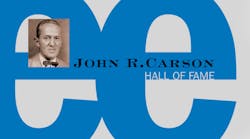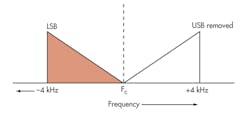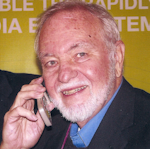John Renshaw Carson: Pioneer Ruled Modulation’s Earliest Innovations
This year, we recognize John R. Carson for two major contributions to communications technology: the invention of single-sideband (SSB) modulation and his rule for estimating frequency modulation (FM) bandwidth. We still use these cornerstones of communications theory today.
The Man
While we remember innovations, we often know less about those who developed them. More commonly known as J.R. Carson, John Renshaw Carson was born in Pittsburgh on June 28, 1886. He and his twin brother, Joseph Robb Carter, both attended Princeton University and graduated in 1907 with bachelor of science degrees. For interested researchers, Princeton’s Mudd Manuscript Library has a collection of letters exchanged between John and Joseph, mainly about the state of student life at the University in 1903 and 1904.
This file type includes high resolution graphics and schematics when applicable.
John went to the Massachusetts Institute of Technology in 1907 and 1908 but returned to Princeton where he earned a degree in electrical engineering in 1909 and a master’s degree in electrical engineering in 1912. Carson taught electrical engineering at Princeton for a while and left the university in 1914 to join AT&T.
Carson’s serious career began at AT&T where he worked as both an electrical engineer and a mathematician. Very early in his work, he invented SSB modulation. He filed for the patent entitled “Method and Means for Signaling with High Frequency Waves” on December 1, 1915. After significant litigation, he was granted patent #1449382 on March 27, 1923. SSB has had a significant impact on telephony as well as radio communication.
The young engineer performed a significant amount of mathematical analysis of communications methods. He analyzed frequency modulation and debated Edwin Armstrong, the inventor of FM, regarding FM’s noise benefits. In his paper “Notes on the Theory of Modulation,” published in February 1922 in the Proceedings of the Institute of Radio Engineers (now IEEE), he put forth his now well-known Carson’s rule about FM bandwidth.
Carson moved to Bell Telephone Laboratories in 1925 and worked there until his early death in 1940. In 1926 McGraw Hill published his book Electrical Circuit Theory and Operational Calculus. The book is an organized collection of material gleaned from the many technical papers he wrote for the Bell Labs technical journals. You can still get a copy of it from Amazon. In 1937, he received an honorary doctor of science degree from Brooklyn Polytechnic Institute in recognition for his many contributions to telephony and radio technology.
Carson never got to see all of the real benefits of his work. While he did see the use of SSB in telephone networks, he did not witness the surge in SSB usage in radio after World War II.
Single-Sideband Modulation
SSB is a special form of amplitude modulation (AM) in which the carrier is suppressed and one sideband is removed. The benefit is the significant reduction in bandwidth needed to transmit information using modulation compatible with the wire or radio channel (see the figure).
Carson saw the fruits of his invention as it was used to implement frequency division multiplexing (FDM) techniques in the telephone network. FDM was used to package multiple telephone conversations for long-distance calls over a single line. Each call modulated a subcarrier on a different frequency, and all of the carriers were summed and transmitted on a common line.
The problem was that AM consumed considerable bandwidth because it produced two sidebands around the carrier that occupied a bandwidth twice the highest frequency of the audio to be transmitted. Because the telephone lines, both twisted pair and coax, had limited bandwidth especially over long distances, few calls could be handled. But SSB cut the bandwidth in half, doubling the call capacity. With the telephone system limiting voice spectrum to the 300- to 3400-Hz range, a single call could be transmitted in 4 kHz of bandwidth.
The multiplex system started with 12 calls each modulating carriers spaced 4 kHz in the 60-kHz to 108-kHz range. The modulators were diode ring balanced modulators that suppress the carrier, leaving two sidebands. The lower sideband (LSB) is selected with a sharp LC or crystal filter. The 12 subcarriers were then combined in a linear mixer to form what was known as a basic group.
Up to five basic groups could be further multiplexed on to higher-frequency subcarriers in the 312-kHz to 552-kHz range spaced 48 kHz apart. The upper sidebands (USBs) were used to create a super-group. Then, 10 super-groups could be combined by modulating subcarriers in the 600-kHz to 2540-kHz range to form a master group of 600 calls. Six master groups also could be combined to form a 3600-channel jumbo group. Combining three jumbo groups produced a maximum of 10,600 calls on a single line.
Demultiplexing was accomplished with selective filters to recover the sidebands and balanced modulators to reproduce the original audio. Pilot subcarriers were also transmitted to aid in the demodulation process.
This SSB form of analog multiplexing first came into use in the 1930s and was used extensively throughout the Bell telephone system until the 1970s when digital multiplexing (T1 and T3 lines, etc.) came into use.
The first experiments involving SSB’s use in radio occurred during World War I. Commercial experimentation continued throughout the 1920s and 1930s. After World War II, SSB was adopted by the amateur radio community, which significantly contributed to the practical development of the technology.
The Air Force adopted SSB in the 1950s for long-range bomber communications, but it is no longer used. Today, SSB is one of the dominant modes of amateur radio communications along with FM and CW. SSB is also used in citizen’s band (CB) radios and long-range marine radios.
Another application of SSB is in TV broadcasting. The original U.S. National Television Standards Committee (NTSC) TV standard used vestigial sideband (VSB) modulation, which is a modified form of SSB where one sideband and only a part of the other sideband is suppressed. The TV signal then could fit into the 6-MHz wide channels assigned by the Federal Communications Commission.
Today, digital TV uses VSB again to ensure the TV signal occupies no more than 6 MHz. The digital modulation is 8VSB, where the digital signal is transmitted in eight levels to provide the data rate required for high-definition TV.
Carson’s Rule For FM
FM produces an infinite number of sidebands above and below the carrier. However, an infinite bandwidth is not necessary for transmission as most of the signal energy is concentrated in a more limited range of sidebands around the carrier. The mathematical Bessel functions define the number of sidebands and their amplitudes.
Normally the bandwidth of an FM signal can be computed with:
BW = 2fmN
Here, fm is the highest modulating frequency and N is the number of significant sidebands. A significant sideband is generally regarded as one that has a power of 1% or greater of the carrier amplitude. The N value is derived from a Bessel function table.
Carson’s rule determines the bandwidth based on a significant sideband amplitude of 2% or more. It is expressed as:
BW = 2(fd + fm)
Here, fd is the maximum frequency deviation of the carrier and fm is the maximum modulating frequency.
Carson’s rule applies mainly to analog modulating signals. Since digital modulating signals include many harmonics, the rule does not provide an adequate picture of the necessary bandwidth for digital FM signal integrity. If the highest estimated harmonic can be determined, Carson’s rule may be used to provide a rough estimate of needed bandwidth.



